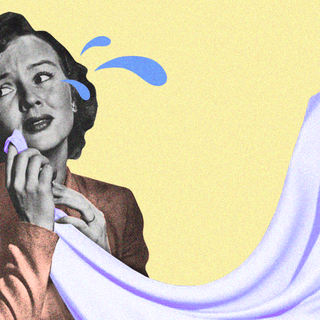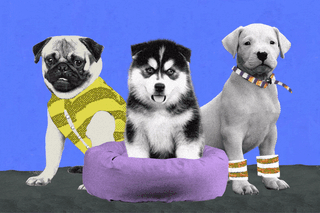
For Urban Indians, Exotic Dogs Are the New Social Media Status Symbol — Fuelling Exploitative Puppy Mills
“Most of the young people are focused purely on getting a good-looking dog. They don’t care where it comes from.”

In the millennium city of Gurugram or even the sanitized limits of Delhi and Mumbai, come sunset, the streets outside towering apartment blocks are usually dotted with consistent visuals: huskies trudging along with corporate honchos jogging in their customized sneakers, chihuahuas fresh from papaya conditioner soaks, Irish Setters in all their fur-laden glory, and a dozen other breeds from across the globe.
The sheer diversity of these beautiful specimens usually inspires a crushing sense of wonderment. “We don’t deserve these beauties!” one might exclaim.
Except, we indeed do not deserve them. Urban Indians have a superficial obsession with exotic breeds of dogs, which not only ignores some damning truths about the way they are procured and bred but also says a lot about our sociology.
According to Dr. Kunal Sharma, a veterinary surgeon at Max Vets, the seeds of our fascination for these exotic breeds can be traced back to the burgeoning group of urban Indians post-independence.
“Even fifty years back in India, dogs were for royalty because ordinary Indians had cattle solely for livelihood and income purposes. When India grew and Indians had more disposable income, they wanted companion animals too. But these animals had to measure up to what these royals had: exotic breeds of dogs.”
Today, our infatuation with celebrities and desire to emulate a superficial idea of the good life feeds into the same aspirations.
“So, if Paris Hilton carries a chihuahua and there are people who are fans of hers, they find it fashionable. Similarly, after the Vodafone ads started featuring pugs, people started buying them without realizing what kind of complications they might have,” Sharma says.
Related on The Swaddle:
Loungewear as ‘Aesthetic’ Is a Symptom of Constant Self‑Optimization
When the Vodafone ads were at their peak around 2007, K.V. Sridhar, an advertising manager, had told Business Today that they had caused a significant spike in the demand for pugs in the country, with over 50,000 dogs imported, mostly illegally.
Globally, the obsession with “aesthetic dogs” has its roots in the British Kennel clubs of the late 19th century. The main motivation behind these clubs was to turn dogs from working animals to ornaments with excessive grooming, canine competitions that tested their physical abilities, and the prestigious “conformational shows” that judged dogs on how closely they resembled the idealized versions of their breeds. The Kennel clubs in India followed the British model and set a cultural precedent for what kind of dogs are celebrated and for what.
“It all comes down to having dogs that are fashionable. The assumption is that when you are walking with the bigger breeds on the street, people will ask you about them, and enquire about the name of the breed.”
According to Abodh Aras, the chief executive officer of the non-profit Welfare for Stray Dogs and a former co-opted member of the Animal Welfare Board of India – our postcolonial fascination with anything foreign is also very much a part of the problem.
In the blind race to own the most trending breeds, urban Indians will do anything it takes to ensure the survival of the exotic dogs – from shaving off their fur or even keeping dogs suited for colder climates locked in air-conditioned rooms. The fact that these dogs end up prisoners in those air-conditioned rooms, with the outdoors too hot for any exercise or frequent walks, becomes irrelevant in the face of the prestige they bring to their owners.
“A friend of mine would keep her husky in an air-conditioned room for days on end,” says Fabian Rodrigues, based in Mumbai. “Eventually, the dog became obese, would just sleep all day, and eventually passed away because of a heart attack. It was only two days later that the house help found out the husky was dead because everyone had assumed he was just sleeping in the corner as usual.”
Dr. Sharma points out that even when it comes to other exotic breeds, “[t]here is a serious lack of awareness about what needs to be done … If you end up buying a chihuahua because you saw Paris Hilton having one, people are unaware that they can’t be kept outdoors in a Delhi farmhouse because they can be picked up by an eagle in the outdoors.”
The pandemic also exponentially increased the demand for exotic dogs, says Dr. Sharma. Besides the want to have a pet by one’s side to contain the dreary loneliness of the lockdown, exotic dogs also worked wonders for “cute” social media posts.
Pet behaviorist Aaron Dsilva says that social media plays an oversized role in urban Indians gravitating towards exotic dogs. “So, the cute reel could be about an exotic dog in Switzerland but you still want it in India. Before social media, it was the commercial ads on TV that always had foreign breeds.”
Social media standards of aesthetics are projected onto exotic dogs too. Just being exotic is not enough – there is always a range of customizations available.
Shivam Mishra, a software developer who also works for animal rights, said that he has witnessed people flattening the noses of pugs – both surgically and by breeding “genetically modified” pugs – so that the pictures look aesthetic. “Due to this, many pugs and Corgi puppies end up developing breathing issues,” he says. “In almost half of these cases, they end up dying of lung disorders and asthma.”
Dr. Sharma adds that dogs are companion animals; they are not reared for milk or meat. “So, for companionship, you don’t necessarily need an exotic breed.”
Related on The Swaddle:
How Instagram Aesthetics Fuel a Destructive Fast Fashion Empire
Urban Indians wanting exotic breeds at any cost ultimately leads to the proliferation of unethical puppy mills, also referred to as backyard breeders for the unhygienic and often fatal conditions in which these dogs are bred. Within these puppy mills, the dogs are reared in chock-a-block cages without vaccinations or paperwork to trace their parents and siblings.
Gayeti Singh, a journalist, discovered the harsh world of puppy mills when she wanted an Irish Setter after her son was born. Even though she knew that the breed is “not readily available in India,” she’d read that they were family dogs, amenable to children.
“I was warned by people that I should get dogs only from ethical breeders, but this went over my head at that time, because I was so desperate that I was choosing not to believe what people were warning me against,” she says.
Singh put out her request on Facebook and the Kennel Club of India and was flooded with options. Although she did try contacting some ethical breeders in south India, the price being quoted was too high and they did not have a litter (live birth of multiple dogs) available at the time.
“This breeder told me he had an Irish Setter pup only for Rs 50,000. When I took the dog to a vet to get it checked, the doctor even warned me that he looked unhealthy. But somehow, the middleman convinced me that everything was alright.”
Within two days, the Irish Setter fell terribly sick as he battled a chronic case of the highly contagious parvovirus. She says that he was admitted to the hospital for almost two weeks and barely survived the ordeal.
“Until it actually happens to you, these things don’t make sense,” Singh says. “I educated myself on the condition of these puppy mills and found out that the puppies there are not from the farms, are never vaccinated, and puppies infected with various viruses are kept in the same cages as the healthy ones.”
Even though Singh’s Irish Setter has recovered from the virus, the veterinarian told her that he will never be completely healthy. “Parvovirus is a completely preventative illness, only if those breeders had vaccinated him.”
In 2018, in order to prevent such unethical breeding, the Central Government notified rules for pet shops under the Prevention of Cruelty to Animals Act, 1960. But the implementation remains poor. Most pet shops and breeders, as we also see in Singh’s case, run afoul of section 8(a) in the rules which stipulate that quarantined or sick animals must not be kept together. The draft rules proposed by the Law Commission in 2015 for the regulation of breeders are yet to be notified. The 2016 ban on the import of exotic breeds also remains ineffective in the face of this nexus and easy fudging of papers.
“These puppy mills get away with not following rules because they are usually owned by local goons,” Singh says. “The legal recourse to holding them accountable is minimal.”
Shivalika Kalra, who runs the Charpaws Foundation, a registered society run by dog lovers in Gurugram, also confirms that most of the unethical puppy mills are run by local goons. “It is very tricky to rescue these dogs because they are hand in glove with the local MP or panchayat. It is easier to rescue exotic dogs when they have run their course – completely emaciated, have heart and liver problems because then they are a burden for these breeders. But mostly, they (more powerful breeders) consciously breed dogs in dangerous conditions even if there is a parvovirus epidemic.”
Dsilva postulates that exotic breeds have become just another capitalist commodity, whose demand fluctuates according to the flavor of the season.
“Initially, everyone wanted a Labrador and then it was a German Shepherd and now it’s a Pitbull,” he says. “Most of the young people are focused purely on getting a good-looking dog. They don’t care where it comes from. So, these dogs end up coming with a lot of destructive behavior, redirected aggression, and [breeds with short muzzles like pugs and bulldogs] get overheated in those uncomfortable walks. They will always feel destructive inside.”
The way Abodh Aras sees it, the solution is not just to stop buying exotic breeds but to increase the adoption of Indie breeds or stray dogs that are resilient and best suited for Indian temperatures; they are loyal companions who need considerably much less care.
“We need to popularize the adoption of the Indian breed and explain to people why they must do so,” he says. “We also need to change our perception that these are poor dogs who need our sympathy but we need to uplift the status of the Indie and tell people these are hardy strays and are just as intelligent, sensitive, and loving as any other exotic breed.”
Arman Khan is a freelance writer and journalist based in Mumbai. He writes on the intersection of gender, lifestyle, and art.
Related


The Internet Fixating on Tom Holland and Zendaya Hypes up Men for the Bare Minimum
